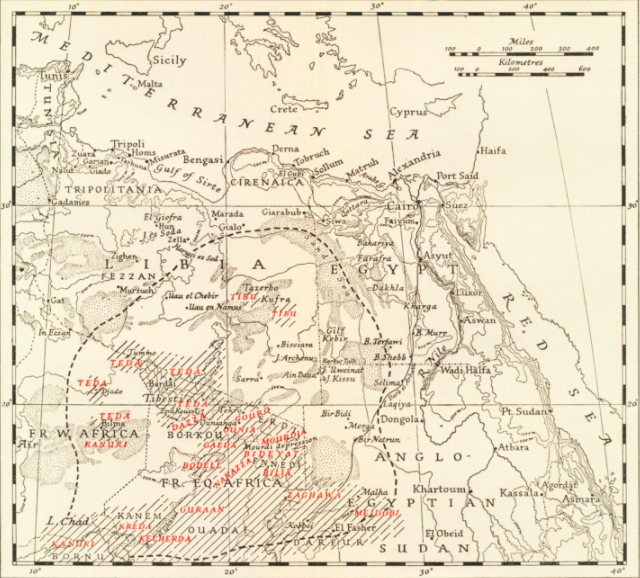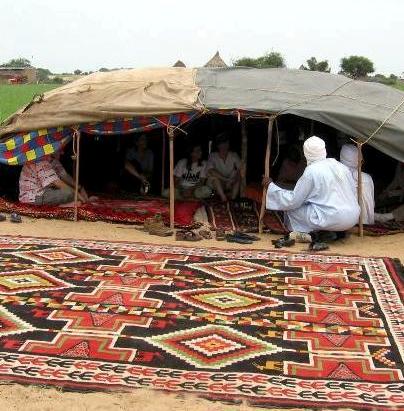|
Toubous
The Toubou or Tubu (from Old Tebu, meaning "rock people") are an ethnic group native to the Tibesti Mountains that inhabit the central Sahara in northern Chad, southern Libya and northeastern Niger. They live either as herders and nomads or as farmers near oases. Their society is clan-based, with each clan having certain oases, pastures and wells. The Toubou are generally divided into two closely related groups: the Teda (or Téda, Toda) and the Dazagara (or Dazzaga, Dazagada, Daza). They are believed to share a common origin and speak the Tebu languages, which are from the Saharan branch of the Nilo-Saharan language family. Tebu is divided further into two closely related languages, called ''Tedaga'' (Téda Toubou) and ''Dazaga'' (Dazaga Gouran). Of the two groups, the Daza, found to the south of the Teda, are more numerous. The Toubou people are also referred to as the Tabu, Tebu, Tebou, Tibu, Tibbu, Toda, Todga, Todaga, Tubu, Tuda, Tudaga, or Gorane people. The Dazaga are ... [...More Info...] [...Related Items...] OR: [Wikipedia] [Google] [Baidu] |
Tibesti Mountains
The Tibesti Mountains are a mountain range in the central Sahara, primarily located in the extreme north of Chad, with a small portion located in southern Libya. The highest peak in the range, Emi Koussi, lies to the south at a height of and is the highest point in both Chad and the Sahara. Bikku Bitti, the highest peak in Libya, is located in the north of the range. The central third of the Tibesti is of volcanic origin and consists of five volcanoes topped by large depressions: Emi Koussi, Tarso Toon, Tarso Voon, Tarso Yega and Toussidé. Major lava flows have formed vast plateaus that overlie Paleozoic sandstone. The volcanic activity was the result of a continental hotspot (geology), hotspot that arose during the Oligocene and continued in some places until the Holocene, creating fumaroles, hot springs, mud pools and deposits of natron and sulfur. Erosion has shaped volcanic spires and carved an extensive network of canyons through which run rivers subject to highly irregular ... [...More Info...] [...Related Items...] OR: [Wikipedia] [Google] [Baidu] |
Chad
Chad (; ar, تشاد , ; french: Tchad, ), officially the Republic of Chad, '; ) is a landlocked country at the crossroads of North and Central Africa. It is bordered by Libya to the north, Sudan to the east, the Central African Republic to the south, Cameroon to the southwest, Nigeria to the southwest (at Lake Chad), and Niger to the west. Chad has a population of 16 million, of which 1.6 million live in the capital and largest city of N'Djamena. Chad has several regions: a desert zone in the north, an arid Sahelian belt in the centre and a more fertile Sudanian Savanna zone in the south. Lake Chad, after which the country is named, is the second-largest wetland in Africa. Chad's official languages are Arabic and French. It is home to over 200 different ethnic and linguistic groups. Islam (55.1%) and Christianity (41.1%) are the main religions practiced in Chad. Beginning in the 7th millennium BC, human populations moved into the Chadian basin in great ... [...More Info...] [...Related Items...] OR: [Wikipedia] [Google] [Baidu] |
Oases
In ecology, an oasis (; ) is a fertile area of a desert or semi-desert environmentBattesti, Vincent (2005) Jardins au désert: Évolution des pratiques et savoirs oasiens: Jérid tunisien. Paris: IRD éditions. . that sustains plant life and provides habitat for animals. Surface water may be present, or water may only be accessible from wells or underground channels created by humans. In geography, an oasis may be a current or past rest stop on a transportation route, or less-than-verdant location that nonetheless provides access to underground water through deep wells created and maintained by humans. The word ''oasis'' came into English from la, oasis, from grc, ὄασις, , which in turn is a direct borrowing fro ... [...More Info...] [...Related Items...] OR: [Wikipedia] [Google] [Baidu] |
Bahr El Gazel (region Of Chad)
Barh El Gazel ( ar, منطقة بحر الغزال, french: Région du Barh El Gazel) is one of the 23 regions of Chad. The region's name may also be written as Barh El Gazal or Bahr el Gazel. Its capital is the town of Moussoro. The region was created in 2008 from the former Barh El Gazel Department of the Kanem Region. Geography The region borders Borkou Region to the north, Batha Region to the east, Hadjer-Lamis Region to the south, and Kanem Region to the west. The region is predominantly grassland, merging into the Sahara Desert in the north. Settlements Moussoro is the regional capital; other major settlements include Chadra, Dourgoulanga, Michemiré and Salal. Demographics As per the census of 2009, the population of the region was 260,865, 46.3% female. The average size of household as of 2009 is 5.90: 5.90 in rural households and 5.80 in urban areas. The total number of households was 43,478: 38,160 in rural areas and 5,318 in urban areas. The number of nomads in ... [...More Info...] [...Related Items...] OR: [Wikipedia] [Google] [Baidu] |
Ennedi
The Ennedi Plateau is located in the northeast of Chad, in the regions of Ennedi-Ouest and Ennedi-Est. It is considered a part of the group of mountains known as the Ennedi Massif found in Chad, which is one of the nine countries that make up the Sahelian belt that spans the Atlantic Ocean to Sudan. The Ennedi is a sandstone bulwark in the middle of the Sahara, which was formed by erosion from wind and temperature. Many people occupied this area, such as hunters and gatherers (5,000-4,000 cal BC) and pastoralists (beginning 4,000 cal BC). The Ennedi area is also known for its large collection of rock art depicting mainly cattle, as these animals were the main source of financial, environmental, and cultural impact. This art dates back nearly 7,000 years ago. Today, two semi-nomadic groups, mainly of the Muslim religion, have permanent villages in the Ennedi during the rainy months and pass through the area during the dry season. They rely on their herds of camels, donkeys, sheep, ... [...More Info...] [...Related Items...] OR: [Wikipedia] [Google] [Baidu] |
Bourkou
Borku (french: Borkou) or Borgu (') is a region of Central Africa, mostly in Northern Chad, forming part of the transitional zone between the arid wastes of the Sahara and the fertile lands of the central Sudan. It is bounded N. by the Tibesti Mountains, and is in great measure occupied by lesser elevations belonging to the same system. These hills to the south and east merge into the plains of Ouaddaï and Darfur. South-west, in the direction of Lake Chad, is the Bodele basin. The drainage of the country is to the lake, but the numerous khors with which its surface is scored are mostly dry or contain water for brief periods only. A considerable part of the soil is light sand drifted about by the wind. The irrigated and fertile portions consist mainly of a number of valleys separated from each other by low and irregular limestone rocks. They furnish excellent dates. Barley is also cultivated. The northern valleys are inhabited by a settled population of Gouran stock, known as ... [...More Info...] [...Related Items...] OR: [Wikipedia] [Google] [Baidu] |
Anakaza Tribe
The Anakaza are name clan of Toubou people branch Daza . Olson, James Stuart (1996); "Anakaza"; ''The Peoples of Africa: An Ethnohistorical Dictionary'', Greenwood Press, pp. 28-29. . One of the largest of Daza subgroups, they are a nomadic people traditionally employed in camel-herding. They are mostly located in the Saharan region of Borkou in northern Chad, they can be found in a vast area from Faya-Largeau to Kirdimi and nomadizing an area which goes from Oum Chalouba to the Djourab and Mortcha.Decalo, Samuel (1987); "Anakaza"; ''Historical Dictionary of Chad'', Scarecrow Press, p. 41. . In modern times out of its ranks was born Hissène Habré, president of Chad between 1982 and 1990, who during his tenure in office gave the key positions to his fellow Daza, favouring among the latters his subgroup. The Anakaza also formed the bulk of his élite unit, the Presidential Guard. Another prominent Anakaza is the current rebel leader Mahamat Nouri. Due to his rebellion in 2006 ... [...More Info...] [...Related Items...] OR: [Wikipedia] [Google] [Baidu] |
Sahel
The Sahel (; ar, ساحل ' , "coast, shore") is a region in North Africa. It is defined as the ecoclimatic and biogeographic realm of transition between the Sahara to the north and the Sudanian savanna to the south. Having a hot semi-arid climate, it stretches across the south-central latitudes of Northern Africa between the Atlantic Ocean and the Red Sea. The Sahel part of Africa includes – from west to east – parts of northern Senegal, southern Mauritania, central Mali, northern Burkina Faso, the extreme south of Algeria, Niger, the extreme north of Nigeria, Cameroon and Central African Republic, central Chad, central and southern Sudan, the extreme north of South Sudan, Eritrea and Ethiopia. Historically, the western part of the Sahel was sometimes known as the Sudan region (''bilād as-sūdān'' "lands of the Sudan"). This belt was located between the Sahara and the coastal areas of West Africa. There are frequent shortages of food and water due to the dry ha ... [...More Info...] [...Related Items...] OR: [Wikipedia] [Google] [Baidu] |
Hissène Habré
Hissène Habré (Arabic: ''Ḥusaīn Ḥabrī'', Chadian Arabic: ; ; 13 August 1942 – 24 August 2021), also spelled Hissen Habré, was a Chadian politician and convicted war criminal who served as the 5th president of Chad from 1982 until he was deposed in 1990. A member of Chad's northern population, Habré joined FROLINAT rebels in the first Chadian Civil War against the southern-dominated Chadian government. Due to a rift with fellow rebel commander Goukouni Oueddei, Habré and his Armed Forces of the North rebel army briefly defected to Felix Malloum's government against Oueddei before turning against Malloum, who resigned in 1979. Habré was then given the position of Minister of Defense under Chad's new transitional coalition government, with Oueddei as President. Their alliance quickly collapsed, and Habré's forces overthrew Oueddei in 1982. Having become the country's new president, Habré created a one-party dictatorship ruled by his National Union fo ... [...More Info...] [...Related Items...] OR: [Wikipedia] [Google] [Baidu] |


.jpg)



